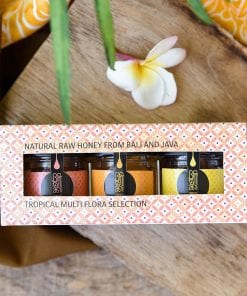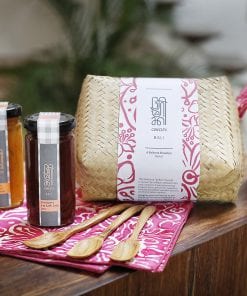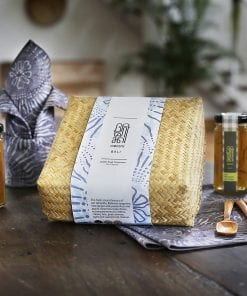Awani Blog
Jam vs. Jelly vs. Marmalades: The Difference
What do you eat with toast, pancakes, tea time scones? How can you make desserts more interesting by adding delicious fruit preserves? Have you tried adding marmalade to make a healthy, flavoursome hot drink or a cocktail? If you look into the pantry or fridge, chances are there are some sweet jams (strawberry at least!) and perhaps a citrus marmalade, or even a jelly. At Awani, we have made award winning tropical fruit preserves since 2007. Our kitchen is on a small farm in the cool volcanic highlands of Bali, Indonesia where we make tropical fruit jams, marmalades and jellies by hand, priding ourselves on coaxing the best flavours from the amazing abundance of tropical fruit that grow in our fertile soil.
Are you a condiment/relish/sweet preserves aficionado? Do you know the difference between a jam, jelly and marmalade? If you do, well done but if you don’t, here is a short guide.
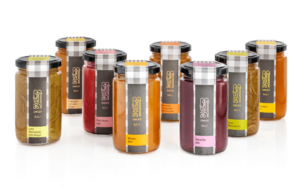
Fruit Jam
The best known fruit jam in the world is strawberry jam. The tradition of making jam in European countries grew from the need to preserve fruit by adding sugar, lemon juice, sometimes pectin, and cooking it gently. Examples of popular jams in Europe are apricot jam, raspberry jam and blackberry jam. Homemade or artisan made jam always tastes better than commercially made jam because it is cooked in small batches, maintaining the distinct flavours of the fruit.
We have adapted this tradition to give it a tropical Balinese, East-West twist and created a range of delicious tropical fruit flavoured jams. We make popular tropical flavours like mango jam and pineapple jam, as well as truly distinctive, unusual flavours like pink guava jam, tamarillo jam
and strawberry kaffir lime jam. Our best seller is pink guava jam. It is tantalisingly fragrant with a pear like texture. It is gorgeous eaten with a warm buttery croissant. Our pink guava season is in March/April each year and our kitchen smells heavenly at that time!
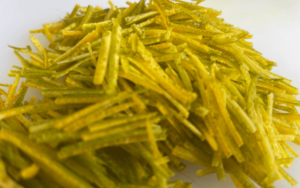
Marmalade
Marmalades are fruit preserves that are always made with a citrus fruit. The origin of marmalade can be traced to Portugal in the 1600s although the best known marmalade of all, orange marmalade, was commercialised in Scotland a little later. As well as citrus fruit, marmalades also contain the rind of the citrus fruit. If you look at the marmalade section in a deli you can buy marmalades with thin cut or thick cut peel, depending on personal taste. The flavours of marmalades vary greatly depending on the type of citrus.
A classic marmalade is Seville orange marmalade. It is rich and robust. Our tropical equivalent is lime guava marmalade which is fragrant and full flavoured. A gentler “lady marmalade” comes in the form of our best selling Balinese tangerine marmalade. It has delightfully light, fragrant citrus flavours and ismade with green skinned sumaga tangerines that grow in Bali. The opposite taste experience is our lime marmalade which will wake up your tastebuds very quickly. The citrus peel in all of our marmalades is handcut and very fine.

Jelly
Jelly differs from jam and marmalade as the fruit mixture is sieved after cooking so the set preserve is clear and does not contain chunks of fruit. Jellies sometimes need the addition of natural pectin or apples to set. Awani makes a gorgeous passionfruit guava jelly. It is not easy to make a jelly that evokes the pure flavours of a fruit and has a pleasing texture that is soft but not runny. The flavours of our passionfruit guava jelly are intense and just a little is needed to complement the food that it is being paired with. Quite often this is cheese. Jelly is an excellent accompaniment for cheese. Our passionfruit guava jelly is delicious with a hard salty cheese like feta.
At Awani, we specialise in making artisan fruit jams, jellies and marmalades from the highest quality tropical fruit that we can source from Bali and Java. We use mangoes, pink guavas, pineapples, passionfruit, tamarillos, limes and tropical Balinese tangerines to make our award winning tropical fruit preserves. Whether a jam, marmalade or jelly, the general rule is if the texture is too hard, then the preserve will be too sweet. If the texture is too soft, then the flavour will run off too soon and you will not experience the full experience of the fruit. The key to creating the best flavours in our preserves is to ensure that we use only the best tropical fruit and to balance the sweetness and acidity in the cooking process. Discover the real flavours of tropical fruit in our tasting sets and gift sets.



